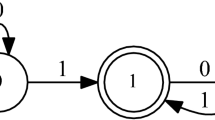Abstract
Fibonaccian number system (FNS) that uses {0,1} as the digit set with Fibonacci numbers as the positional weights, has many interesting properties which can be exploited for various applications. We propose here a new number system, termed as the Tri-digit Fibonaccian Number System (TFNS), with alternate Fibonacci numbers as the positional weights for the various digits in the representation. We show that TFNS provides asymmetric distribution of the three digits (0, 1 and 2) in representing numbers with a pair of consecutive 2’s never appearing in a valid codeword. These properties can conveniently be utilized for typical engineering applications, e.g., message encoding for low-energy communication systems and variable length encoding with self-delimiting code.
Access this chapter
Tax calculation will be finalised at checkout
Purchases are for personal use only
Preview
Unable to display preview. Download preview PDF.
Similar content being viewed by others
References
Ahlbach, C., Usatine, J., Frougny, C., Pippenger, N.: Efficient Algorithms for Zeckendorf Arithmetic. The Fibonacci Quarterly 51(3), 249–255 (2013)
Apostolico, A., Fraenkel, A.: Robust transmission of unbounded strings using fibonacci representations. IEEE Transactions on Information Theory 33, 238–245 (1987)
Fenwick, P.: Zeckendorf Integer Arithmetic. The Fibonacci Quarterly 41, 405–413 (2003)
Fraenkel, A.S.: Systems of Numeration. Amer. Math. Monthly 92(2), 105–114 (1985)
Fraenkel, A., Klein, S.: Combinatorial Algorithms on Words, vol. F12, pp. 169–183 (1985)
Ghosh, R.N., Sinha, K., Sinha, B.P., Datta, D.: TSS: an energy efficient communication scheme for low power wireless networks. In: Proc. 27th IEEE Intl. Performance Computing and Communications Conf (IPCCC), USA, pp. 85–92 (December 2008)
St. John, P.H.: On the Asymtotic Proportions of zeros and Ones in Fibonacci Sequences. The Fibonacci Quarterly 22(2), 144–145 (1984)
Kautz, W.: Fibonacci codes for synchronization control. IEEE Transactions on Information Theory 11, 284–292 (1965)
Knuth, D.E.: The Art of Computer Programming, 3rd edn., vol. 1. Pearson Education (1997)
Mutyam, M.: Preventing crosstalk delay using fibonacci representation. In: IEEE Intl. Conf. on VLSI Design, pp. 685–688 (2004)
Sinha, K., Sinha, B.P., Datta, D.: CNS: a new energy efficient transmission scheme for wireless sensor networks. Wireless Networks 16(8), 2087–2104 (2010)
Sinha, K., Sinha, B.P., Datta, D.: An energy-efficient communication scheme for wireless networks: a redundant radix-based approach. IEEE Transactions on Wireless Communications 10(2), 550–559 (2011)
Zeckendorf, E.: Reprsentation des nombres naturels par une somme des nombres de Fibonacci ou de nombres de Lucas. Bull. Soc. Roy. Sci. Liege 41, 179–182 (1972)
Author information
Authors and Affiliations
Editor information
Editors and Affiliations
Rights and permissions
Copyright information
© 2014 Springer International Publishing Switzerland
About this paper
Cite this paper
Sinha, K., Ghosh, R., Sinha, B.P. (2014). A New Number System Using Alternate Fibonacci Numbers as the Positional Weights with Some Engineering Applications. In: Natarajan, R. (eds) Distributed Computing and Internet Technology. ICDCIT 2014. Lecture Notes in Computer Science, vol 8337. Springer, Cham. https://doi.org/10.1007/978-3-319-04483-5_18
Download citation
DOI: https://doi.org/10.1007/978-3-319-04483-5_18
Publisher Name: Springer, Cham
Print ISBN: 978-3-319-04482-8
Online ISBN: 978-3-319-04483-5
eBook Packages: Computer ScienceComputer Science (R0)




